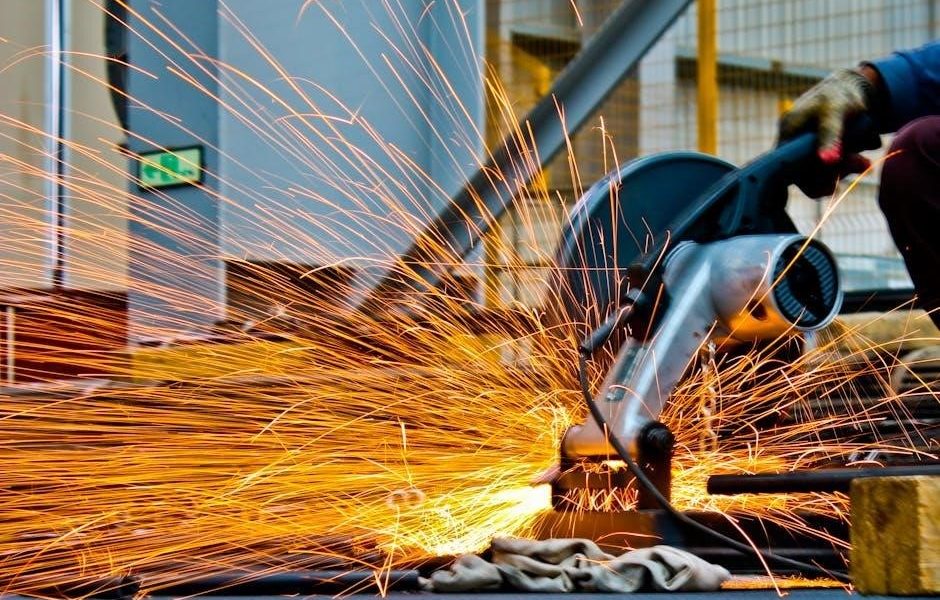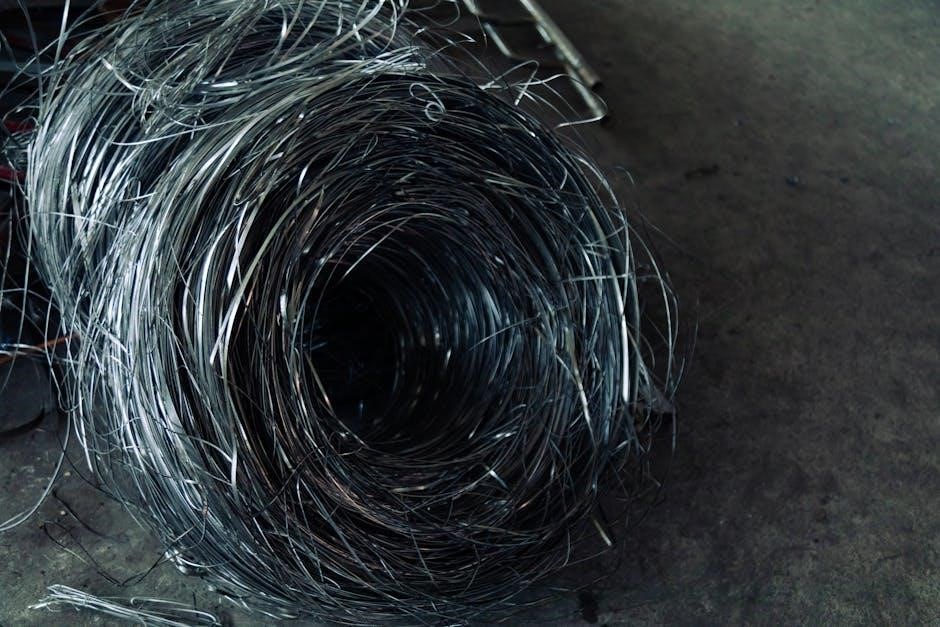
pipe cutting guide
Pipe cutting is a fundamental process in plumbing‚ construction‚ and manufacturing‚ requiring precision and accuracy for safe and reliable outcomes. It involves severing pipes to specific lengths using various tools and techniques‚ ensuring structural integrity and proper fitting. Accurate pipe cutting is essential for maintaining system efficiency and safety‚ making it a critical skill for professionals and DIYers alike. This guide provides a comprehensive overview of tools‚ methods‚ and best practices to help you master pipe cutting effectively.
1.1 Importance of Accurate Pipe Cutting
Accurate pipe cutting ensures safety‚ efficiency‚ and professional results. Properly cut pipes prevent leaks‚ structural weaknesses‚ and system failures. Precise measurements and clean cuts are essential for seamless installations and durability. Inaccuracies can lead to costly repairs‚ making accuracy a critical priority in all piping projects.
1.2 Brief Overview of Pipe Cutting Methods
Pipe cutting methods vary based on material‚ thickness‚ and desired precision. Common techniques include manual cutting with hacksaws or pipe cutters‚ power cutting using angle grinders or circular saws‚ and specialized methods like laser or CNC cutting for high-precision applications. Each method offers unique advantages‚ ensuring versatility for different piping needs and projects.

Essential Tools and Equipment for Pipe Cutting
Having the right tools is crucial for efficient pipe cutting. Essential tools include hacksaws‚ pipe cutters‚ angle grinders‚ circular saws‚ and specialized machines for precise‚ clean cuts.
2.1 Manual Cutting Tools (e.g.‚ Hacksaws‚ Pipe Cutters)
Manual cutting tools like hacksaws and pipe cutters are indispensable for precise pipe cutting. Hacksaws are ideal for cutting metal pipes‚ while pipe cutters are perfect for plastic and copper. These tools offer portability and cost-effectiveness‚ making them essential for small projects. Regular blade replacement and proper maintenance ensure clean cuts and extend tool longevity.
2.2 Power Tools (e.g.‚ Angle Grinders‚ Circular Saws)
Power tools like angle grinders and circular saws offer speed and efficiency for cutting pipes. Angle grinders are versatile for cutting various materials‚ while circular saws excel at straight‚ precise cuts. They are ideal for heavy-duty tasks and large pipe diameters. Always use proper safety gear and maintain tools for optimal performance and longevity.
2.3 Specialized Equipment (e.g.‚ Pipe Cutting Machines)
Specialized pipe cutting machines are designed for high-precision and efficient cutting‚ often used in industrial settings. These machines can handle various pipe materials and diameters‚ ensuring clean and accurate cuts. They are ideal for repetitive tasks and large-scale projects. While more expensive‚ they offer superior performance‚ consistency‚ and durability‚ making them a valuable investment for professionals. Proper maintenance is essential for optimal functionality.

Safety Precautions and Best Practices
Pipe cutting requires strict safety measures to prevent accidents. Always wear PPE‚ secure the pipe firmly‚ and ensure proper ventilation. Keep sparks away from flammable materials and maintain a clean workspace. Regularly inspect tools and follow manufacturer guidelines to ensure safe and efficient cutting operations.
3.1 Personal Protective Equipment (PPE)
Wearing proper PPE is crucial for safety during pipe cutting. This includes safety glasses to protect eyes from debris‚ gloves for grip and hand protection‚ and ear protection from loud machinery. A dust mask or respirator may also be necessary‚ depending on the material being cut. Ensure all PPE fits correctly and is appropriate for the specific cutting method being used.
3.2 Workspace Preparation and Safety Measures
A clean‚ well-organized workspace is essential for safe pipe cutting. Clear the area of flammable materials and ensure good ventilation to prevent gas buildup. Secure the pipe firmly to prevent movement during cutting. Keep a fire extinguisher nearby and avoid loose clothing that could get caught in tools. Proper lighting and a stable work surface are also vital for accurate and hazard-free cutting operations.

Choosing the Right Cutting Method
Selecting the appropriate pipe cutting method depends on the material‚ thickness‚ and desired precision. Consider factors like speed‚ accuracy‚ and tool availability to ensure optimal results for your project.
4.1 Cutting Methods for Different Pipe Materials
- Steel pipes are typically cut using hacksaws‚ angle grinders‚ or circular saws for precise‚ clean edges.
- PVC and plastic pipes can be cut with utility knives‚ plastic pipe cutters‚ or saws for smooth finishes.
- Copper pipes are often cut using tubing cutters or reciprocating saws to avoid crimping or deforming the material.
- PEX pipes require specialized PEX cutters to ensure straight‚ leak-free cuts without damaging the flexible material.
4.2 Factors Influencing the Choice of Method
The choice of cutting method depends on the pipe material‚ thickness‚ and desired finish. Steel pipes often require saws or grinders‚ while plastic pipes may use utility knives or cutters. Safety considerations‚ such as avoiding sparks with metal pipes‚ also play a role. Additionally‚ tool accessibility‚ pipe diameter‚ and the cutter’s skill level influence the selected technique for optimal results.
Measuring and Marking Pipes
Accurate measurement ensures precise cuts‚ using tools like tape measures or calipers. Marking pipes clearly with a pencil or marker guarantees visibility‚ while straightedges or pipe markers aid alignment for straight cuts.
5.1 How to Measure Pipes Accurately
Use a tape measure or caliper to determine pipe length or diameter. Ensure the pipe is stable and measure from end to end for straight cuts. Read measurements carefully‚ noting outer diameter (OD) and inner diameter (ID) for precise fitting. Double-check with a square or circle test to confirm alignment. Always verify measurements before marking to avoid errors.
5.2 Techniques for Marking Cut Lines
Use a marker or soapstone to clearly mark cut lines on pipes‚ ensuring visibility. For curved pipes‚ wrap a flexible measuring tape or use a template. Align marks with a straightedge for straight cuts. Double-check measurements before marking. For visibility‚ use paint or a permanent marker‚ especially on dark materials. Clamp pipes to prevent movement during marking for accurate results.
Cutting Techniques for Specific Pipe Materials
Different pipe materials require specialized cutting techniques. Steel pipes are often cut with saws or grinders‚ while PVC and plastic pipes use plastic cutters. Copper pipes are typically cut with tubing cutters for clean‚ precise edges. Each material demands specific tools and methods to ensure safe‚ accurate‚ and efficient cutting.
6.1 Cutting Steel Pipes
Cutting steel pipes requires robust tools and techniques. Common methods include using hacksaws‚ angle grinders‚ or specialized steel pipe cutters. For precise cuts‚ especially in thick-walled pipes‚ power tools like circular saws or reciprocating saws are effective. Always secure the pipe firmly to prevent movement and apply consistent pressure for a clean cut. Safety gear‚ including gloves and goggles‚ is essential to protect against sharp edges and debris.
6.2 Cutting PVC and Plastic Pipes
Cutting PVC and plastic pipes is typically done using hand saws‚ utility knives‚ or plastic pipe cutters. Ensure the pipe is secure and marked clearly for a straight cut. A miter box can help achieve precise angles. After cutting‚ deburr the edges to prevent cracking and ensure smooth connections. Clean the cut area before gluing or fitting to maintain integrity and durability.
6.3 Cutting Copper Pipes
Copper pipes can be cut using tubing cutters‚ angle grinders‚ or saws. For precise cuts‚ secure the pipe firmly and use a tubing cutter‚ which provides a clean finish. After cutting‚ deburr the edges to prevent leaks and ensure smooth connections. Always maintain the pipe’s integrity to avoid deformation‚ especially when using power tools. This method is ideal for plumbing and DIY projects.
Advanced Pipe Cutting Techniques
Advanced techniques involve precision cutting for complex geometries and materials. Methods like laser cutting offer high accuracy‚ while CNC machines enable automated‚ repeatable results. These techniques ensure consistency and efficiency in demanding applications‚ making them ideal for industrial and specialized projects requiring utmost precision and reliability.
7.1 Cutting Curved or Angled Pipes
Cutting curved or angled pipes requires specialized tools and techniques to maintain accuracy and structural integrity. Using adjustable pipe cutters or CNC machines ensures precise cuts‚ while laser cutting offers high accuracy for complex shapes. Proper alignment and careful planning are essential to achieve smooth‚ clean cuts without compromising the pipe’s strength or functionality‚ especially in applications demanding custom fits and precise angles.
7.2 Precision Cutting for Welding and Fittings
Precision cutting is crucial for welding and fitting applications‚ ensuring smooth connections and structural integrity. Using specialized tools like pipe cutters or CNC machines guarantees exact measurements and clean edges. Laser cutting offers high accuracy for complex geometries‚ while proper alignment and technique minimize material waste. Achieving precise cuts is essential for secure welds and fittings‚ ensuring long-term durability and reliability in piping systems.
Tips for Beginners
Start with proper PPE and tools suited for the pipe material. Measure accurately‚ mark clearly‚ and cut slowly to maintain control. Practice on scrap pieces to build confidence and skill.
8.1 Common Mistakes to Avoid
- Rushing the cut‚ leading to uneven edges or damage to the pipe.
- Using the wrong tool for the pipe material‚ causing inefficiency or safety risks.
- Ignoring safety precautions‚ such as not wearing PPE or improperly securing the pipe.
- Measuring incorrectly‚ resulting in incorrect lengths or angles.
- Applying too much pressure‚ which can warp or break the pipe.
8.2 Improving Cutting Efficiency and Accuracy
- Use the right tool for the pipe material and thickness to ensure clean cuts.
- Measure twice and cut once to avoid waste and errors.
- Keep blades and cutting tools sharp for precise results.
- Practice cutting techniques on scrap material before working on actual projects.
- Secure the pipe firmly during cutting to prevent movement and uneven cuts.

Advanced Tools and Technologies
Advanced tools like laser cutters and CNC machines offer high precision and automation‚ enabling complex cuts with minimal effort. These technologies enhance efficiency and accuracy in industrial applications.
9.1 Laser Cutting for High-Precision Applications
Laser cutting offers unparalleled precision‚ ideal for intricate cuts in various pipe materials. It minimizes material waste and ensures smooth edges‚ making it perfect for high-precision applications. This method is highly efficient and reducing the need for additional finishing‚ making it a preferred choice in industrial settings where accuracy and quality are paramount.
9.2 CNC Machines for Automated Pipe Cutting
CNC machines provide advanced automation for precise pipe cutting‚ enabling rapid and consistent results. These machines use computer-controlled systems to ensure accuracy‚ reducing human error. Ideal for complex cuts and high-volume applications‚ CNC machines boost efficiency while maintaining quality‚ making them a valuable asset in modern manufacturing and industrial pipe cutting processes. They are highly customizable and adaptable to various pipe materials and sizes.
Mastering pipe cutting requires precision‚ safety‚ and the right tools. Always measure accurately‚ use appropriate techniques‚ and follow safety guidelines. Practice improves efficiency and accuracy‚ ensuring professional results.
10.1 Key Takeaways for Successful Pipe Cutting
Accurate measurement and marking are crucial for precise cuts. Choosing the right tool ensures efficiency and safety. Always wear PPE and follow safety guidelines. Regular tool maintenance enhances performance. Practice improves skill‚ and adhering to best practices ensures professional results. Proper material handling and workspace preparation prevent accidents. Patience and attention to detail are key to mastering pipe cutting techniques.
10.2 Final Safety and Efficiency Checklist
- Always wear PPE‚ including safety glasses and gloves‚ to protect against debris and sharp edges.
- Ensure the workspace is well-ventilated and free from flammable materials.
- Double-check measurements and markings before cutting to avoid costly mistakes.
- Use the appropriate tool for the pipe material to ensure clean‚ precise cuts.
- Regularly maintain tools to prevent dull blades and equipment malfunction.
- Keep a fire extinguisher nearby and follow all safety protocols.
Related posts:
Archives
- October 2025
- September 2025
- August 2025
- July 2025
- June 2025
- May 2025
- April 2025
- March 2025
- February 2025
- January 2025
- December 2024
- November 2024
- October 2024
- September 2024
- August 2024
- July 2024
- June 2024
- May 2024
- April 2024
- March 2024
- February 2024
- January 2024
- December 2023
- November 2023
- October 2023
- September 2023
- August 2023
- July 2023
- June 2023
- May 2023
Calendar
| M | T | W | T | F | S | S |
|---|---|---|---|---|---|---|
| 1 | 2 | |||||
| 3 | 4 | 5 | 6 | 7 | 8 | 9 |
| 10 | 11 | 12 | 13 | 14 | 15 | 16 |
| 17 | 18 | 19 | 20 | 21 | 22 | 23 |
| 24 | 25 | 26 | 27 | 28 | 29 | 30 |
Leave a Reply
You must be logged in to post a comment.